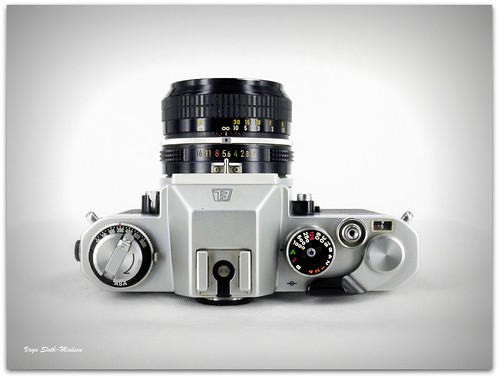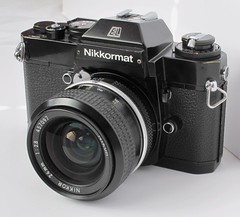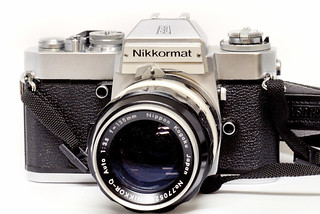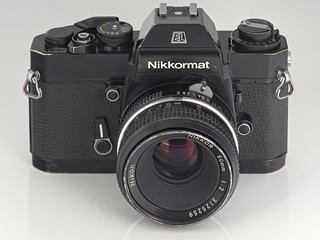Difference between revisions of "Nikomat/Nikkormat EL/ELW"
Hanskerensky (talk | contribs) (Added link to user manual page) |
(→Links) |
||
| (6 intermediate revisions by one other user not shown) | |||
| Line 7: | Line 7: | ||
|image_rights= wp | |image_rights= wp | ||
}} | }} | ||
| − | The [[Nikon]] '''Nikomat EL''' (in Japan) or '''Nikkormat EL''' (elsewhere) was introduced in 1972. It was one of | + | The [[Nikon]] '''Nikomat EL''' (in Japan) or '''Nikkormat EL''' (elsewhere) was introduced in 1972. It was one of Nikon's first attempts at producing a camera with electronic control. It features an electronically-timed shutter ranging from 4 seconds to 1/1000. Its center-weighted CdS meter enables aperture-priority automatic exposure, but it is a pre-AI body requiring the "twist-twist" used on early Nikons to index the maximum aperture of each mounted lens. Electronic flash sync is at speeds up to 1/125th second. Power is provided by a PX28 6.2 volt silver-oxide battery, inserted into a chamber at the bottom of the mirror box. The shutter and metering are disabled to conserve battery power until the film-advance lever is pulled outwards, uncovering a red dot. |
| − | The '''Nikomat ELW''' (in Japan) or '''Nikkormat ELW''' (elsewhere) was introduced in 1975. | + | The camera is decidedly weighty compared to its peers of the era, and is considered a tech's nightmare, due to the point-to-point wiring of the electronics.<ref>"Dismantling the EL involves the tedious process of de-soldering no fewer than 19 wires." notes a ''Popular Photography'' teardown. (Later cameras would substitute "flat flex" multiconductor ribbon cables.) Norman Goldberg & Michele Frank, "Lab Report: Nikkormat EL," March 1974 ''Popular Photography'' (Vol. 74, No. 3), pg. 94.</ref> |
| + | |||
| + | The '''Nikomat ELW''' (in Japan) or '''Nikkormat ELW''' (elsewhere) was introduced in 1975. This is a black version of the EL, adding connections for the AW-1 autowinder. "W" is not added to the "EL" pentaprism badge, it is only present as a prefix to the serial number. As the winder takes over from the manual film-advance lever, a collar around the shutter release offers a duplicate "on" switch for the electronics. The shutter release is only mechanically locked when both switches are off, i.e. neither red dot shows. | ||
| + | |||
| + | ==Notes== | ||
| + | <references/> | ||
==Links== | ==Links== | ||
*[https://www.butkus.org/chinon/nikon/nikkormat_el/nikkormat_el.htm Nikkormat EL user manual] at [https://www.butkus.org/chinon/ Butkus.org] | *[https://www.butkus.org/chinon/nikon/nikkormat_el/nikkormat_el.htm Nikkormat EL user manual] at [https://www.butkus.org/chinon/ Butkus.org] | ||
*[https://www.butkus.org/chinon/nikon/nikkormat_elw/nikkormat_elw.htm Nikkormat ELW user manual] at [https://www.butkus.org/chinon/ Butkus.org] | *[https://www.butkus.org/chinon/nikon/nikkormat_elw/nikkormat_elw.htm Nikkormat ELW user manual] at [https://www.butkus.org/chinon/ Butkus.org] | ||
| − | *[ | + | *[https://imaging.nikon.com/history/chronicle/cousins07-e/index.htm Nikomat EL] at Nikon's [http://imaging.nikon.com/history/ History & Technology site] |
| − | *[ | + | *[https://imaging.nikon.com/history/chronicle/cousins08-e/index.htm Nikomat ELW and Nikon EL2] at Nikon's [http://imaging.nikon.com/history/ History & Technology site] |
*[http://www.mir.com.my/rb/photography/hardwares/classics/nikkormat/elseries/el/index.htm First] of a series of pages on the Nikkormat EL at the [http://www.mir.com.my/rb/photography/hardwares/classics/nikkormat/html/index.htm Nikkormat site] within "[http://www.mir.com.my/rb/photography/companies/nikon/htmls/models/index.htm A Pictorial History of Nikon Cameras]" | *[http://www.mir.com.my/rb/photography/hardwares/classics/nikkormat/elseries/el/index.htm First] of a series of pages on the Nikkormat EL at the [http://www.mir.com.my/rb/photography/hardwares/classics/nikkormat/html/index.htm Nikkormat site] within "[http://www.mir.com.my/rb/photography/companies/nikon/htmls/models/index.htm A Pictorial History of Nikon Cameras]" | ||
*[http://www.mir.com.my/rb/photography/hardwares/classics/nikkormat/elseries/elw/index.htm First] of a series of pages on the Nikkormat ELW at the [http://www.mir.com.my/rb/photography/hardwares/classics/nikkormat/html/index.htm Nikkormat site] within "[http://www.mir.com.my/rb/photography/companies/nikon/htmls/models/index.htm A Pictorial History of Nikon Cameras]" | *[http://www.mir.com.my/rb/photography/hardwares/classics/nikkormat/elseries/elw/index.htm First] of a series of pages on the Nikkormat ELW at the [http://www.mir.com.my/rb/photography/hardwares/classics/nikkormat/html/index.htm Nikkormat site] within "[http://www.mir.com.my/rb/photography/companies/nikon/htmls/models/index.htm A Pictorial History of Nikon Cameras]" | ||
| − | + | * [https://youtu.be/gHwsUlmcFTI Nikkormat EL video presentation] by YouTuber [https://www.youtube.com/@MrKayFisher Kay's Cameras] | |
{{br}} | {{br}} | ||
{|class=floatleft | {|class=floatleft | ||
Latest revision as of 18:41, 4 April 2024

|
| 1/1000 to 4 seconds plus "A" image by Vagn Sloth-Madsen (Image rights) |
The Nikon Nikomat EL (in Japan) or Nikkormat EL (elsewhere) was introduced in 1972. It was one of Nikon's first attempts at producing a camera with electronic control. It features an electronically-timed shutter ranging from 4 seconds to 1/1000. Its center-weighted CdS meter enables aperture-priority automatic exposure, but it is a pre-AI body requiring the "twist-twist" used on early Nikons to index the maximum aperture of each mounted lens. Electronic flash sync is at speeds up to 1/125th second. Power is provided by a PX28 6.2 volt silver-oxide battery, inserted into a chamber at the bottom of the mirror box. The shutter and metering are disabled to conserve battery power until the film-advance lever is pulled outwards, uncovering a red dot.
The camera is decidedly weighty compared to its peers of the era, and is considered a tech's nightmare, due to the point-to-point wiring of the electronics.[1]
The Nikomat ELW (in Japan) or Nikkormat ELW (elsewhere) was introduced in 1975. This is a black version of the EL, adding connections for the AW-1 autowinder. "W" is not added to the "EL" pentaprism badge, it is only present as a prefix to the serial number. As the winder takes over from the manual film-advance lever, a collar around the shutter release offers a duplicate "on" switch for the electronics. The shutter release is only mechanically locked when both switches are off, i.e. neither red dot shows.
Notes
- ↑ "Dismantling the EL involves the tedious process of de-soldering no fewer than 19 wires." notes a Popular Photography teardown. (Later cameras would substitute "flat flex" multiconductor ribbon cables.) Norman Goldberg & Michele Frank, "Lab Report: Nikkormat EL," March 1974 Popular Photography (Vol. 74, No. 3), pg. 94.
Links
- Nikkormat EL user manual at Butkus.org
- Nikkormat ELW user manual at Butkus.org
- Nikomat EL at Nikon's History & Technology site
- Nikomat ELW and Nikon EL2 at Nikon's History & Technology site
- First of a series of pages on the Nikkormat EL at the Nikkormat site within "A Pictorial History of Nikon Cameras"
- First of a series of pages on the Nikkormat ELW at the Nikkormat site within "A Pictorial History of Nikon Cameras"
- Nikkormat EL video presentation by YouTuber Kay's Cameras
|
|
|
| Nikon 35mm SLR Cameras | |
|---|---|
| Nikkorex F | Nikon EL2 | Nikon EM | Nikon F | Nikon F2 | Nikon F3 | Nikon F4 | Nikon F5 | Nikon F6 | Nikon F50 | Nikon F55 | Nikon F60 | Nikon F65 | Nikon F70 | Nikon F75 | Nikon F80 | Nikon F90 | Nikon F90X | Nikon F100 | Nikon F-301 | Nikon F-401 | Nikon F-401S | Nikon F-401X | Nikon F-501 | Nikon F-601 | Nikon F-601M | Nikon F-801 | Nikon F-801s | Nikon FA | Nikon FE | Nikon FE2 | Nikon FE10 | Nikon FG | Nikon FG-20 | Nikon FM | Nikon FM2 | Nikon FM2n | Nikon FM3A | Nikon FM10 | |
| Nikomat / Nikkormat | |
| EL | EL2 | ELW | FS | FT | FT2 | FT3 | FTN | |


